| At a Glance | |
|---|---|
| Product | ASUSTOR AS5002T and AS5004T |
| Summary | High performance Intel Celeron two and four-bay NASes |
| Pros | • Wide range of downloadable apps • Consistent File Copy Write and Read performance for all RAID levels • Quiet • Aggressively priced |
| Cons | • Slow RAID volume rebuilds |
Introduction
ASUSTOR produces several NAS families that appeal to either “Personal to Home” or “Home to Power User” buyers. Last May, I reviewed ASUSTOR’s “2-series” (AS-20xTE) entry level line that features an Atom CE5310 processor. This family predictably ranked toward the bottom of the NAS Charts.
Several weeks later, Tim reviewed the “3 series” (AS-30XT) that feature a beefier Atom CE5335. The improved hardware resulted in much better performance. Tim concluded that products in the 3-series “deserve to be on your short list if you are looking for the current best value in two or four-bay NASes.”
This review will focus on the latest additions to the Home to Power User product line, the AS5002T (2-bay) and AS5004T (four bay) NASes. As you might suspect from the product numbering scheme, the “5 series” uses a faster processor that produces better results than the 3 series. We’ll find out in the performance and ranking sections if the 5 series is an even better value than the 2 and 3 series NASes.
The chart below, generated from the ASUSTOR website, compares the 2, 3 and 5 series products. For this comparison, I chose the AS-204TE, as that model has an HDMI port that’s lacking in the AS-204T but is included on the 3 and 5 series products. Otherwise, the processor and memory is the same within each product family.
Moving from the 2 series to 5 series, you can see a clear progression to an increasingly powerful processor. The memory on the AS500XT is also expandable up to a total 8 GB. With the 5 series, you also pick up a third USB 3.0 port, 2 eSATA ports and a second Gigabit Ethernet port.
The 5 series also has improved audio output with a digital optical S/PDIF port. In addition, the 5 series moves away from an internal power supply to an external power supply, which appears to be more efficient both in Operation and Hibernate modes. With 2 drives, we measured 17 W / 10 W (active / power save) and with four drives we measured 31 W / 16 W. You’ll note that each of the products is built in the exact same-sized case.
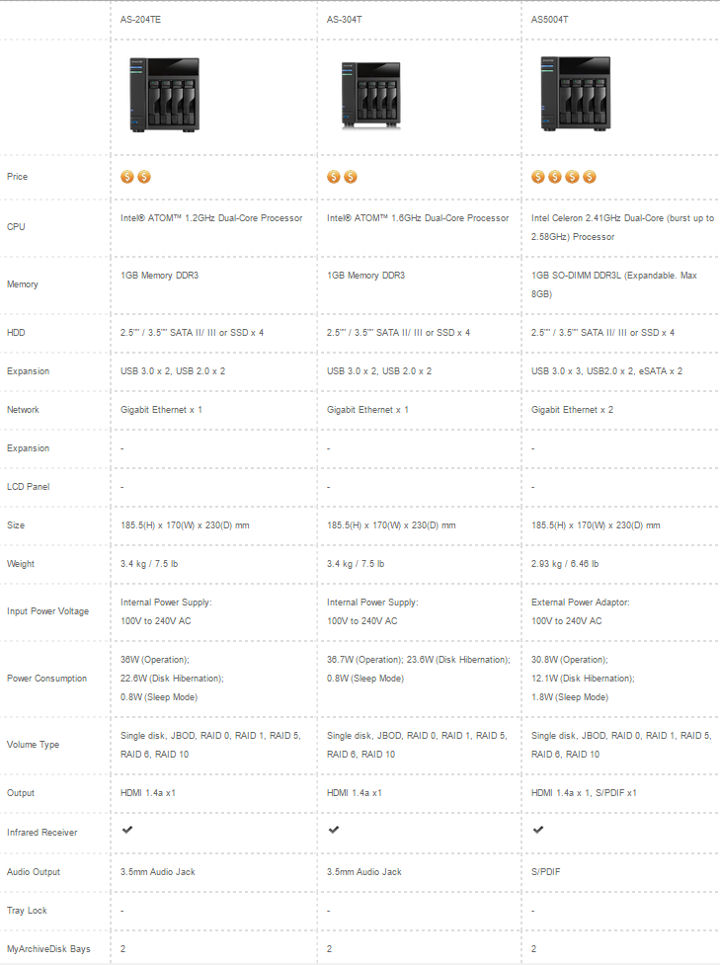
Comparison of ASUSTOR 2, 3, and 5 Series NASes
Product Tour
The Quick Installation Guide and User Guide are common to all “5” series products. The image below appears to be a cropped image of an AS5008T 8-bay NAS, as the drive bays are horizontal instead of the vertical drive trays found on the AS5004T. The 8 and 10 bay models also have four Ethernet ports, compared to the two found on the AS500XT.
The front panel contains LEDs for each hard disk and individual LEDs for power, system status, and USB and two LEDs for Network. Like the 2 and 3 series NASes, neither the AS5002T nor the AS5004T have an LCD information panel. An LCD panel can be found on other models, however. In addition to the indicators, one of the device’s three USB 3.0 ports is located in the lower left corner.
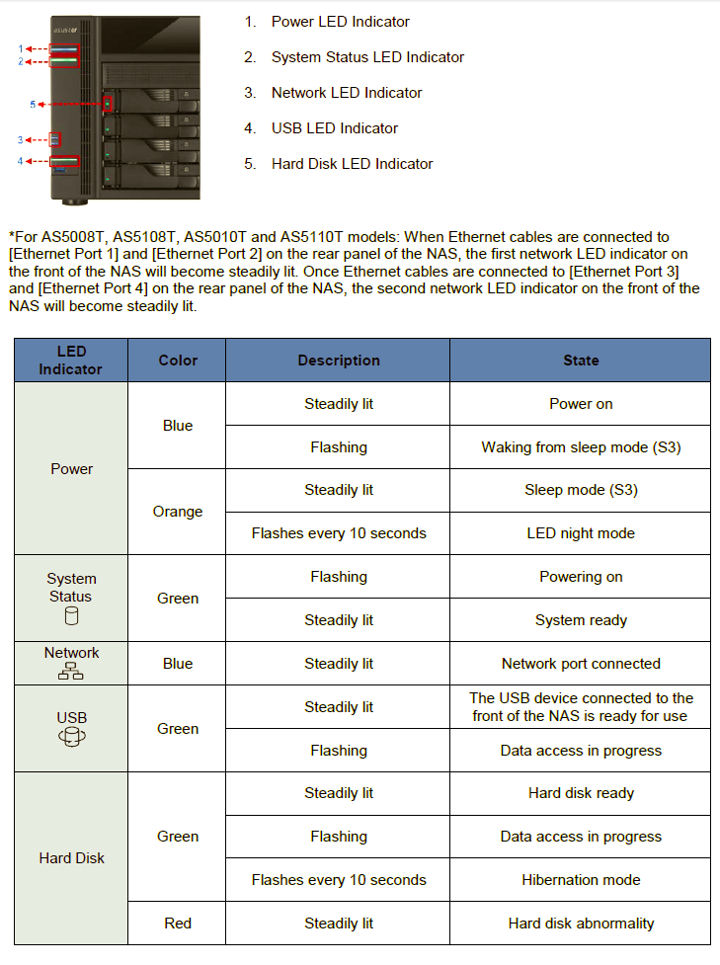
ASUSTOR front panel callouts
As noted above, the ASUSTOR AS500XT have moved to an external power supply, so there’s now only a jack for DC input (#7). The rear panel has a S/PDIF digital audio port rather than the 3.5mm audio jack found on the 2 and 3 series, a reset button, USB 3.0 port (x2), and HDMI port, dual Gigabit Ethernet ports, USB 2.0 ports (x2), system fan and security lock hole.
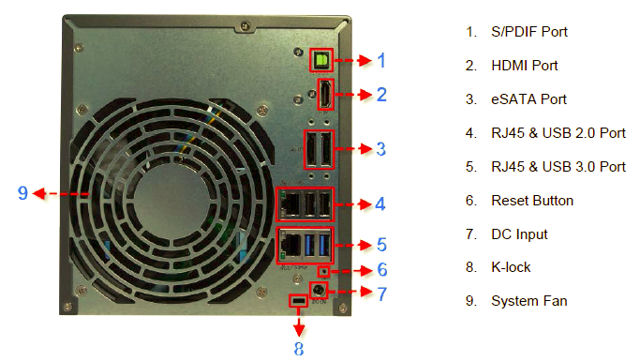
ASUSTOR rear panel callouts
Inside
The AS500XT NASes are powered by an Intel Celeron J1800 running at 2.4 GHz. The memory is a 1 GB SoDIMM, which is upgradeable to 8 GB.
The chart below shows the ASUSTOR 2, 3, and AS500XT series key components.
| ASUSTOR AS-204TE | ASUSTOR AS-304T | ASUSTOR AS5004T | |
|---|---|---|---|
| CPU | Intel Atom CE5310 @ 1.2 GHz (dual core) | Intel Atom CE5335 @ 1.6 GHz (dual core) | Intel Celeron J1800@ 2.4GHz (dual core) |
| RAM | 1 GB DDR3 on board | 1 GB DDR3 on board | 1 GB DDR3 SoDIMM, upgradeable to 8 GB |
| Flash | 16 MB Spansion FL128SAIF00 | 16 MB Spansion FL128SAIF00 | ADATA IUM01-001GFHL (128 MB USB DOM) |
| Ethernet | Realtek RTL8211E | Realtek RTL8211E | Broadcom BCM57781 (x2) |
| USB 3.0 | Etron Tech EJ188H | Etron Tech EJ188H | ASM1074 |
| SATA | Asmedia ASM1061 | Asmedia ASM1061 | ASM1061 (x2) ASM1466 (x2) |
Key component summary and comparison
Below is a photo of the component side of the PCB for the AS5004T. The processor is covered by a large heat sink. To the right of the processor is the connector for the drive backplane. While this is clearly a different board than what you find in the 2 and 3 series products, the footprint is identical.
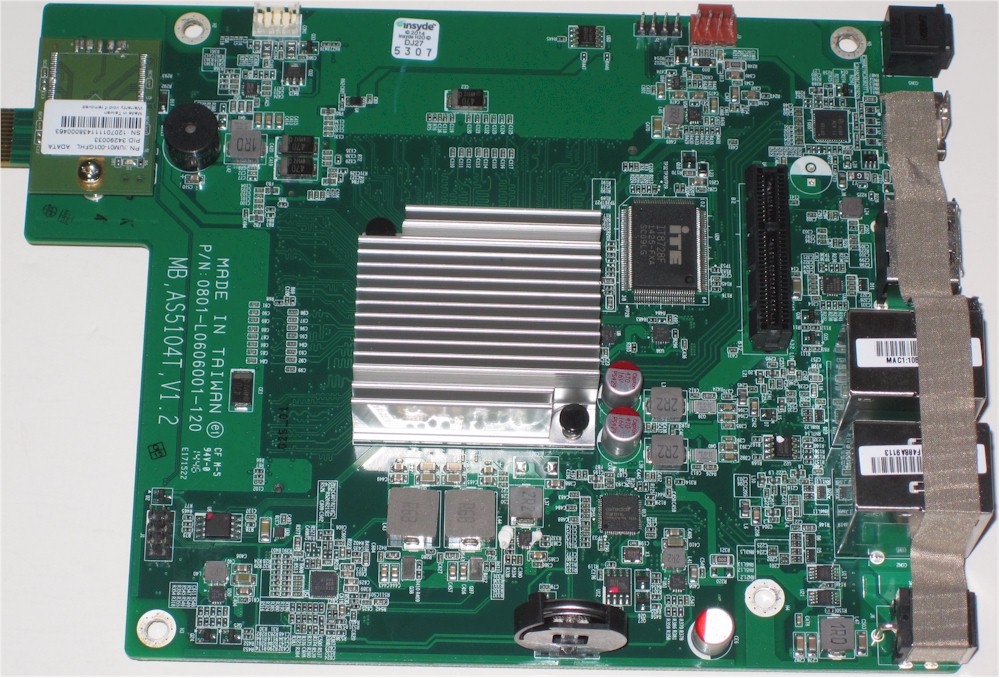
ASUSTOR AS500XT PCB component side
The bottom of the PCB shows the SoDIMM memory slot. Note the slot on the right of the photo has the 1 GB SoDIMM secured with latex caulk. If you want to upgrade to a full 8 GB, you’ll have to pull out this RAM to make room for a second 4 GB SoDIMM.
RAM is easy to get at, however. Just remove the case cover and lift the flaps in a protective anti-static plastic cover to get at them.
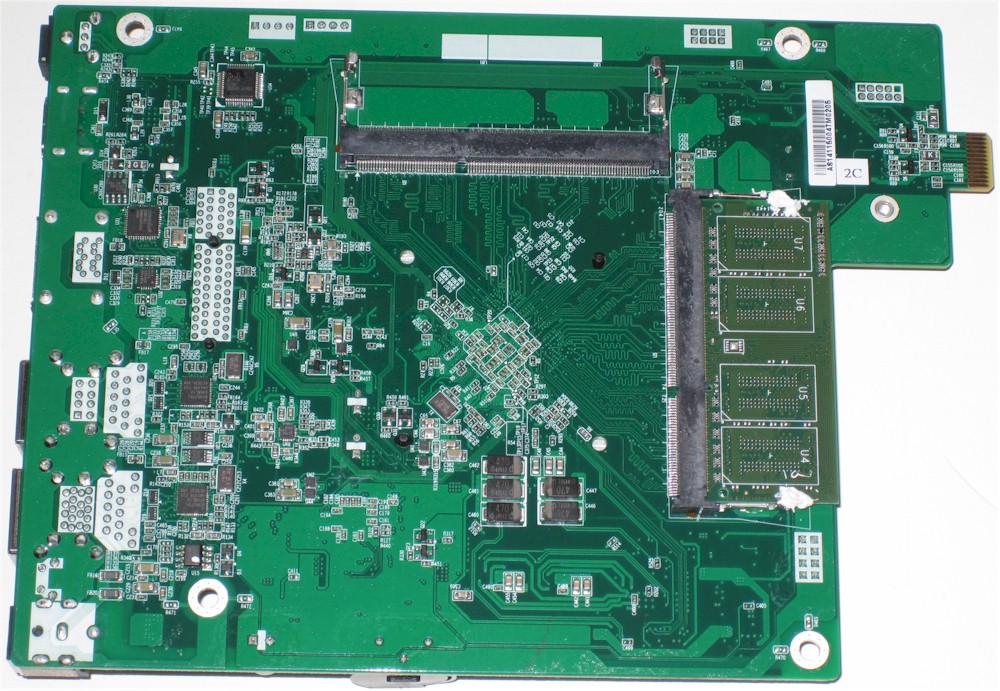
ASUSTOR AS500XT PCB bottom side
Features
Like all NAS manufacturers, ASUSTOR is constantly upgrading its operating system and adding new features. When we reviewed the 2 and 3 series NASes, both were running ADM 2.1.1. In early December of last year, ASUSTOR announced that all products were upgrading to ADM 2.3. ASUSTOR’s Press Release summarizes the new features and apps included in the latest release. To save you a mouse click, here are the new functions taken from the press release.
- Refreshed and modernized user interface featuring enhanced browsing smoothness and speed
- New sign in page featuring customizable styles for the creation of a unique NAS experience
- Support for TFTP server
- Support for proxy server connections
- ACL advanced permissions management provides added convenience for IT professionals
- Smart sleep mode allows the hard disks to automatically enter into hibernation when idle for a specified period of time allowing for effective power saving
- SMB 2.0 support increases Windows networking performance by 30%-50%
To give you a feel for the new user interface, here’s a screenshot of the landing page. As with Android devices, if you have more than one page of icons, you can scroll left or right. If you want to check out the new operating system, you can visit ASUSTOR’s live demo page and navigate your way through the interface and App Central. In App Central , you can download additional programs that run on the server platform and add functionality to your ASUSTOR NAS.

ASUSTOR ADM 2.3 demo landing page
The feature list for the AS500XT NASes, lines up pretty well with what was published in the “2 series” review. You can also check complete specifications for the AS500XT series.
Performance
ADM 2.3.1.R1K3 firmware was loaded onto an AS5004T and performance tests were run using the Revision 5 NAS test process. Since the AS5002T uses the same processor, RAM and Ethernet components, all testing was done on the AS5004T. The AS5004T tests used four drives configured in single RAID 0, 5 and 10 volumes. The AS5002T tests used two drives in single RAID 0 and 1 volumes. All tests were run using our estern Digital Red 3 TB (WD30EFRX) drives provided by WD.
Normally, the first chart that I look at when evaluating NAS performance is the default NAS Chart that looks at File Copy Write Performance. I filter for the number of drives and the latest test method (black bars) and see where the NAS being currently reviewed appears.
The composite image below shows how the AS5002T (left) and the AS 5004T (right) compare to other products matching the filters. Both of the ASUSTOR AS500XT tests turned in virtually identical scores of ~ 110 MBps and ranked near the top of the charts. File Copy Read performance was similar, at 106.4 MB/s (AS5002T) and 107.7 MB/s (AS5004T) and both ranked near the top of the charts for their filtered products.
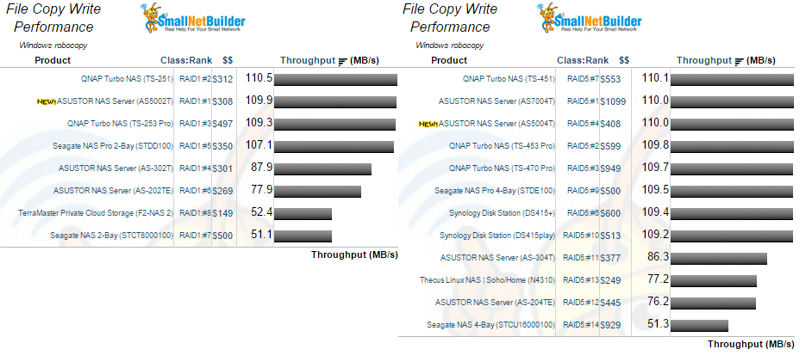
ASUSTOR AS5002T (left) and AS 5004T (right) file copy write performance ranking filter for number of drives and test method
Next, I look at the Benchmark Summary, which shows all test results for each product. In the composite image below, you’ll note that for both the AS5002T (left) an the AS5004T (right), the results are remarkably consistent. There was really very little difference in the File Copy Write and File Copy Read numbers for any tested RAID level for either set of tests run. Many tests, including USB3.0 and eSATA attached backup tests, are well above 100 MB/s.
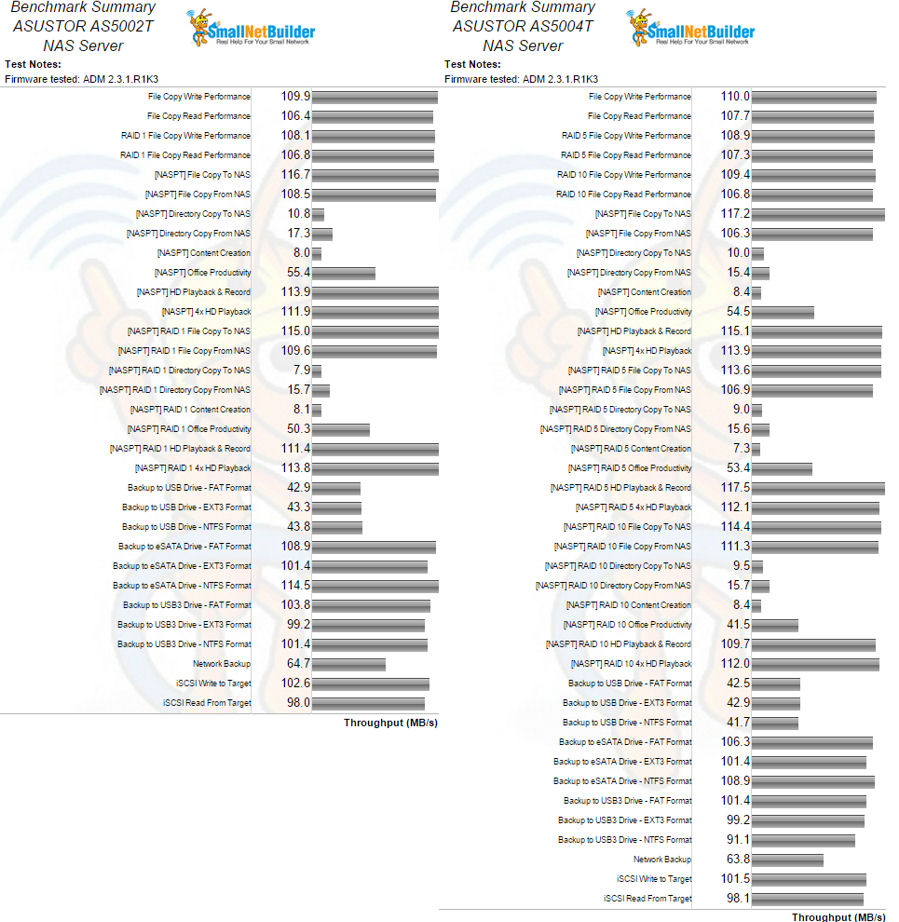
ASUSTOR AS5002T (left) and AS 5004T (right) benchmark summaries
The NAS Ranker really does all of the hard work of comparing NAS performance tests, weighing results by test category and coming up with a Total NAS ranking. The NAS Ranker has recently been updated and simplified. In the new version, you can filter products by test method version (Revision 4 or 5) and Class (No RAID, Raid1 or RAID5). You can still sort by rank or by price (in ascending or descending order).
RAID 1 Class NAS Ranking
First, let’s look at the RAID1 class, which includes the AS5002T as well as other 2-bay NASes. I filtered for Test method Revision 5 (the current process) and generated a chart for Total NAS ranking. In the composite image below, this ranking is shown on the left and shows the AS5002T is the top ranked RAID1 NAS. Being at the top of the charts means that there are no other NASes that match the filter with better performance at a lower price.
The AS5002T really delivers the “bang for the buck”. To see how it stacks up to the competition, I also sorted by ascending price. Those results are shown on the right. The #8, #6 and #4 ranked NASes are cheaper, and two of the cheaper ones are the ASUSTOR AS-202TE (#6) and ASUSTOR AS-302T (#4).
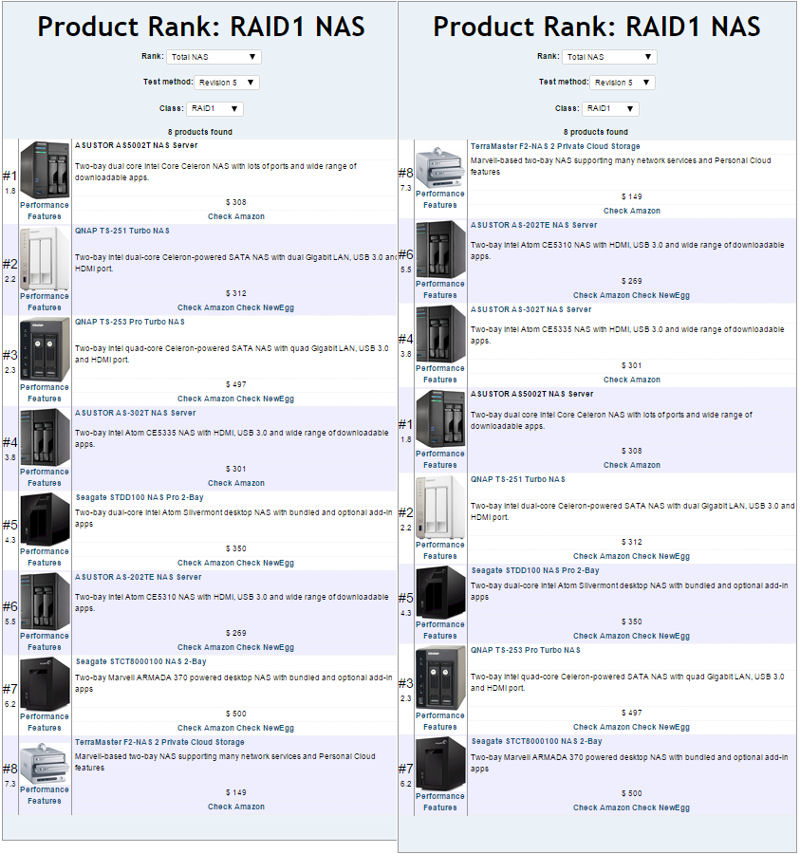
TOTAL NAS Rank for RAID 1
For comparison, I decided to include performance summaries for the #2 ranked QNAP TS-251 Turbo NAS, which is only $4 more expensive and the #4 ranked ASUSTOR AS-302T, which is $7 cheaper than the AS5002T. For this comparison, the AS5002T had four #1 category wins (Total NAS, Read Benchmarks, Backup and iSCSI). The QNAP TS251 and one #1 category win for mixed Read Write, just edging out the ASUSTOR AS52002T by placing #2 for Read Benchmarks.![]()
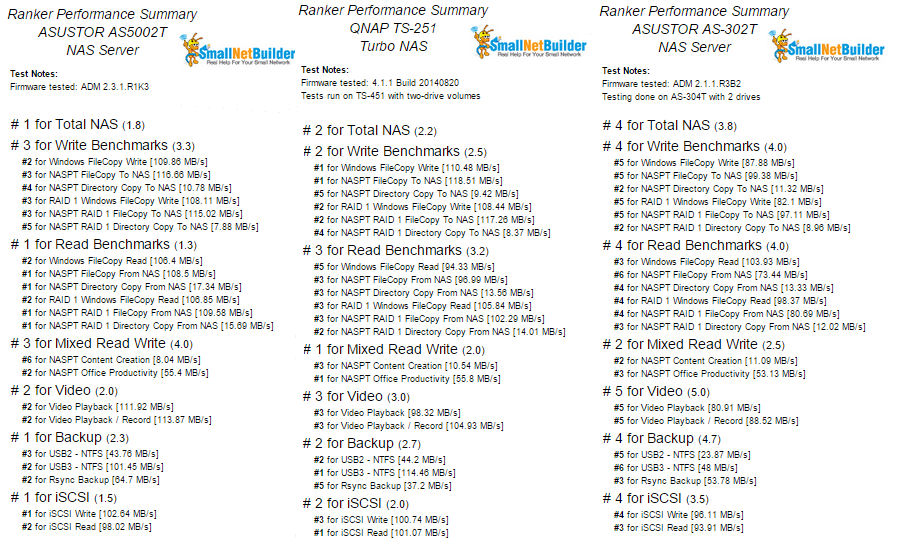
Ranker Performance Summary comparison
Performance – more
RAID 5 Class NAS Ranking
As with the RAID 1 rankings above, I used the NAS ranker to filter for RAID 5 class products, which include the ASUSTOR AS5004T and applied the Test Method filter for Revision 5. In the composite image below, the Total NAS ranking is shown on the left, and the results, sorted by ascending price, are displayed on the right.
The results were somewhat different than for the RAID 1 results above. Here, the #1 product is more than twice the price of the ASUSTOR AS5004T, and there is a three-way tie for #2. While there are five NASes with a Total NAS rank above the AS5004T, all of them are significantly more expensive.
Looking at the chart on the right, sorted by ascending price, the ASUSTOR AS5004T looks pretty good ranked at #4. The other products cheaper than the AS5004T are ranked #11 and #13. Interestingly, the #11 product is the ASUSTOR AS-304T.
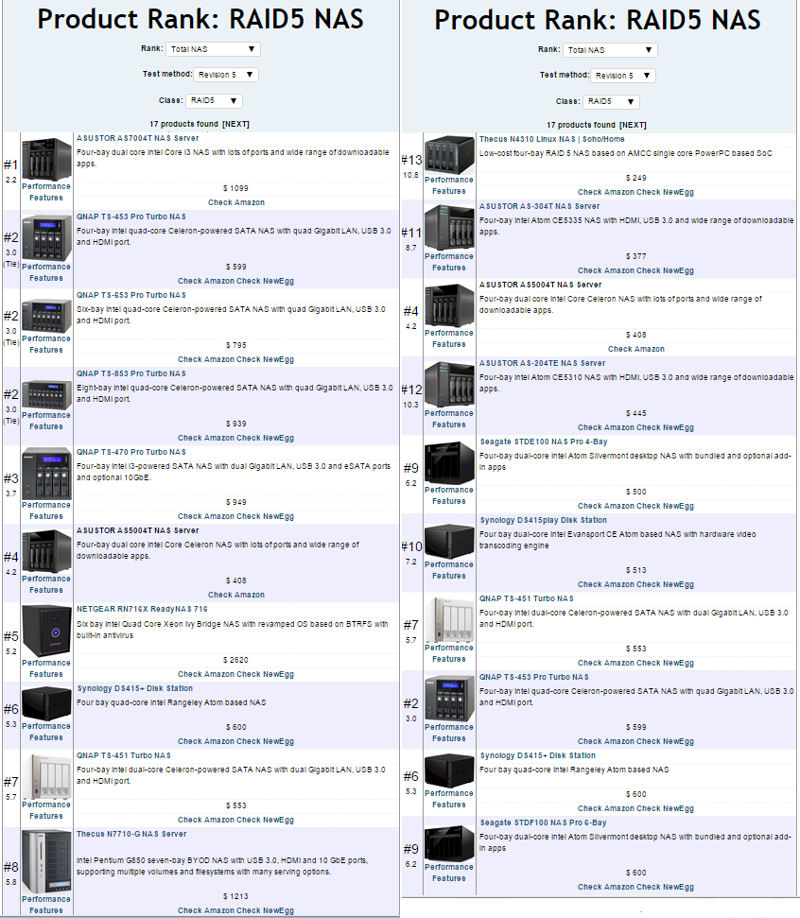
TOTAL NAS Rank for RAID 5
For RAID 5, I decided to compare the two products that were closest in price to the $408 ASUSTOR AS5004T, the $377 ASUSTOR AS-304T and $445 ASUSTOR AS-204TE. This really looks like a pricing anomaly, as the poorer performing AS-204TE, ranked #12, is actually priced more than the significantly faster AS5004T. Let’s look at the performance summaries.
Looking at the subcategories, the results were pretty much as expected. The AS5004T outperformed both of its siblings in every subcategory and for Total NAS – and by a significant amount. In addition, the AS-304T outperformed the higher priced and lower performing entry model AS204TE, as expected, in every subcategory except for Mixed Read Write.
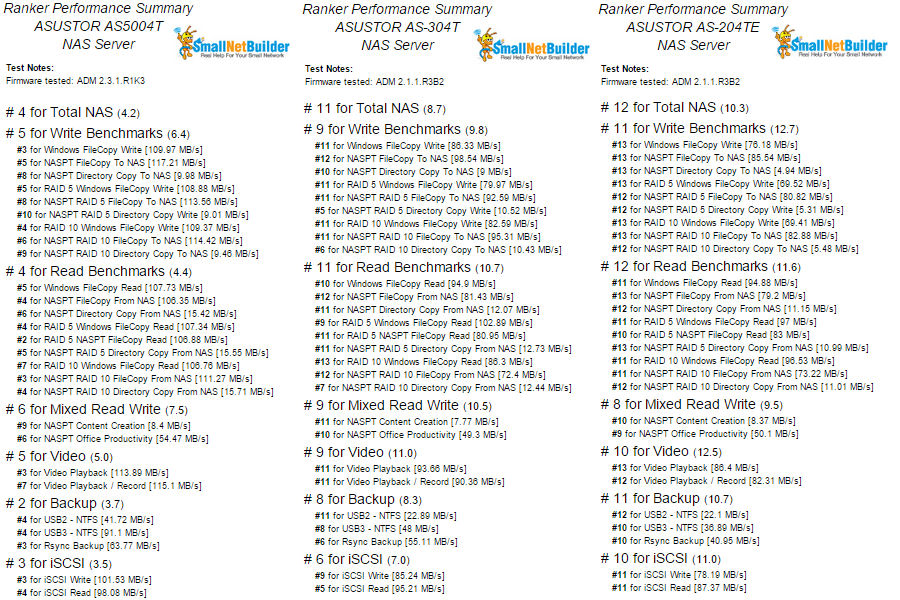
Ranker Performance Summary comparison
Closing Thoughts
ASUSTOR seems to be following QNAP’s business model of having a lot of NASes (perhaps too many) with similar price and performance and running a common operating system. The introduction of the AS500XT family offers a significant upgrade in power and performance compared to the AS-302T and AS-304T. The AS5002T tops the performance charts and is only $7 more expensive (Amazon pricing at time of review) than the AS-302T. Why would you even consider the AS-302T, when you pick up a second Gigabit Ethernet port, 2 eSATA ports, one more USB 3.0 port and S/PDIF audio output with the AS5002T?
Similarly, for the AS5004T, while there are a number of products with better performance rankings, they are hundreds of dollars more than the $408 AS5004T. Though priced $31 more than its lesser-powered AS-304T sibling, it handily won every performance subcategory in the NAS Ranker performance comparison. And the AS-204TE; what can I say? With the price/performance anomaly I pointed out, I’d be surprised if they sold very many at a price that’s higher the much better performing AS5002T.
As Tim concluded in his AS-30XT review, ASUSTOR is gaining a reputation for high performance NASes at affordable prices. The AS5002T and AS5004T have just raised the bar – and possibly spelled the demise of some of its 2 and 3 series NASes.![]()
